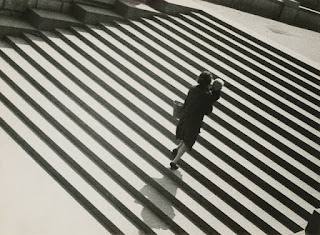http://time.com/104072/paul-strand-retrospective/
-Paul Strand (1890-1976) was a pictorialist until visiting a
gallery owned by Alfred Stieglitz. Stieglitz criticized the graphic softness of
his work which inspired Strand to completely change his style and direction. “straight
up” documentary style, believing that the use of technology, especially the
camera, could improve humankind.
- Blind is a blind
lady in NYC. Strand would put a fake lens on his camera and really photograph
the subject with a lens hidden under his arm. Documented photography but kept
the clean aesthetics of modernism.
-Wall Street has no focal point and seems
abstract, ugly at the time. Straight shot of workers going about their day.
Overall he wanted to use modern art to show the humanity seen in western
artistic traditions.
1916, 1915
-Strand visited New Mexico 1930-1932, made portraits of
artistic friends & acquaintances. Returned in 1934 to photograph art,
architecture, and landscape of the area.
Near Saltillo, 1933
-Lissitzky’s work spoke for the prevailing political
discourse of his native Russia, and Soviet Union.
-Used color and basic shapes to make strong political
statements.
-USSR Russische
Ausstellung (1929). To show the equality of men and women.
-The
Runner (1930) Split into vertical sections to symbolize movement. Visual
fragmentation when one looks at the parts rather than the whole.
-The Staircase (1930) Alexander Rodchenko- used unusual angles and perspective. Woman with a child placed among the manmade enviromnet. Off kilter angle of the stairs and her shadow is cropped partway out of the photo. Random dark portions of the environment in 3 out of 4 of the corners.
-The Staircase (1930) Alexander Rodchenko- used unusual angles and perspective. Woman with a child placed among the manmade enviromnet. Off kilter angle of the stairs and her shadow is cropped partway out of the photo. Random dark portions of the environment in 3 out of 4 of the corners.
-Compositions such as this were an
important influence on New Vision, the modernist photography movement that
gripped Europe in the 1920s and '30s.
Ships in the Lock (1933) Rodchenko
-Lavenson was another pictorialist turned modernist, due to
critiques from Edward Weston. She emphasized formal qualities of architecture,
machinery, and still lifes.
-inspired by the idea of light on metal and the way it would
gleam in the sunshine.
-Joined f/64 photo club in 1932, produced stark depictions
of nature in the American west. The group was about conformity and presented a
unified way about what the new modernist approach for art should be.
Composition in Glass (1931) Alma Lavenson



































